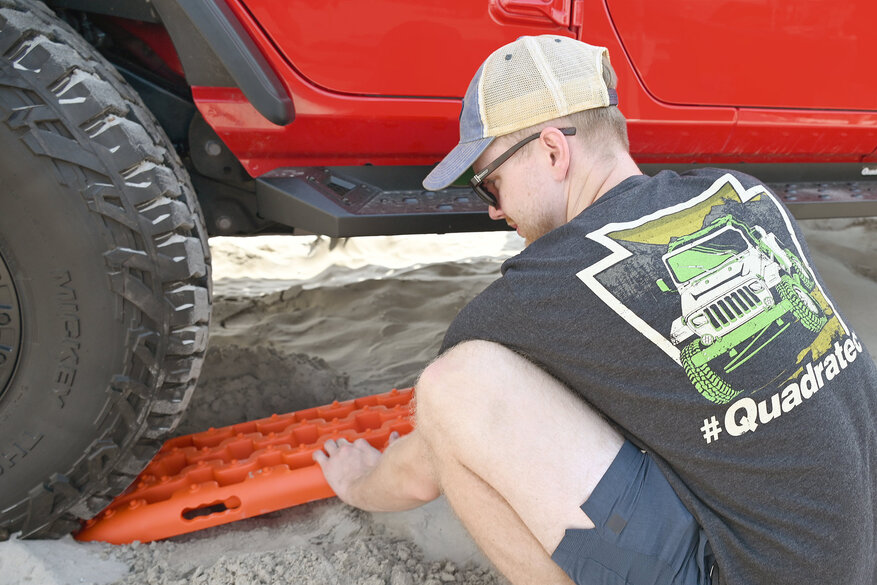by Matt Konkle
Torque Managing Editor
There is no shame in getting stuck when off-roading. Truth is, trouble can lurk around any bend for both the inexperienced, and experienced, driver. It happens. And when it does, hopefully you will have the right tools to pull off whatever recovery is needed — either for yourself or whoever in the group is sidelined.
It could mean that you or someone in your group tried to power over an obstacle and has become high-centered, or possibly looked to get through a mud pit without realizing the depth. Perhaps it is even something like getting stopped cold during a water crossing that was more difficult than you thought.
Regardless, a difficult situation can arise from the most innocent of things sometimes, so having the right gear in your recovery kit is really the best way to overcome the variety of things you may face when on the trail.
After all, you are bringing some food and water for the trip, right? And if your plans are to camp out following your trail adventures, then surely you have a tent and camping accessories as well. Adding some important recovery gear to the mix simply makes sense.
Additionally, you may think you don't need anything because others in your group will carry whatever is important. But that may not always be the case. Even if someone does have good recovery gear, they may not be near enough to you for it to do any good. So, it is always safer to make sure you have the things you need. Not only does this ensure you can handle any mishap yourself, but it can also help the vehicles in front and behind you as well.
So what type of recovery products are best to bring along for the ride? Well, there are certainly plenty of choices, however here are the top off-road and recovery tools we've found are best to include in your kit.

Recovery Boards
It should go without saying, but traction is extremely important when riding off-road. And that traction can quickly disappear thanks to stuff like mud, sand, snow and uneven terrain. That’s when the wheels start spinning and if you are not careful, you just dig yourself into a deeper mess.
So instead of spinning your way into a long, stagnant afternoon, make sure you have a solid set of recovery boards along for the ride. This item is designed with deep cleats or teeth on a long board to help tires regain that traction and get out of messy situations.
The idea of these boards is easy. Dig out some space under one or more tires, insert the board under the tire(s) as far as possible, and then apply a little throttle to roll out from whatever is holding you back.
While some boards come with plastic teeth, you may want to upgrade to something that has replaceable aluminum teeth, or heavy-duty nylon that won’t wear down. Those plastic versions can be a bit less expensive, but a few hard tire spins thanks to a heavy foot and plastic teeth can melt right off.
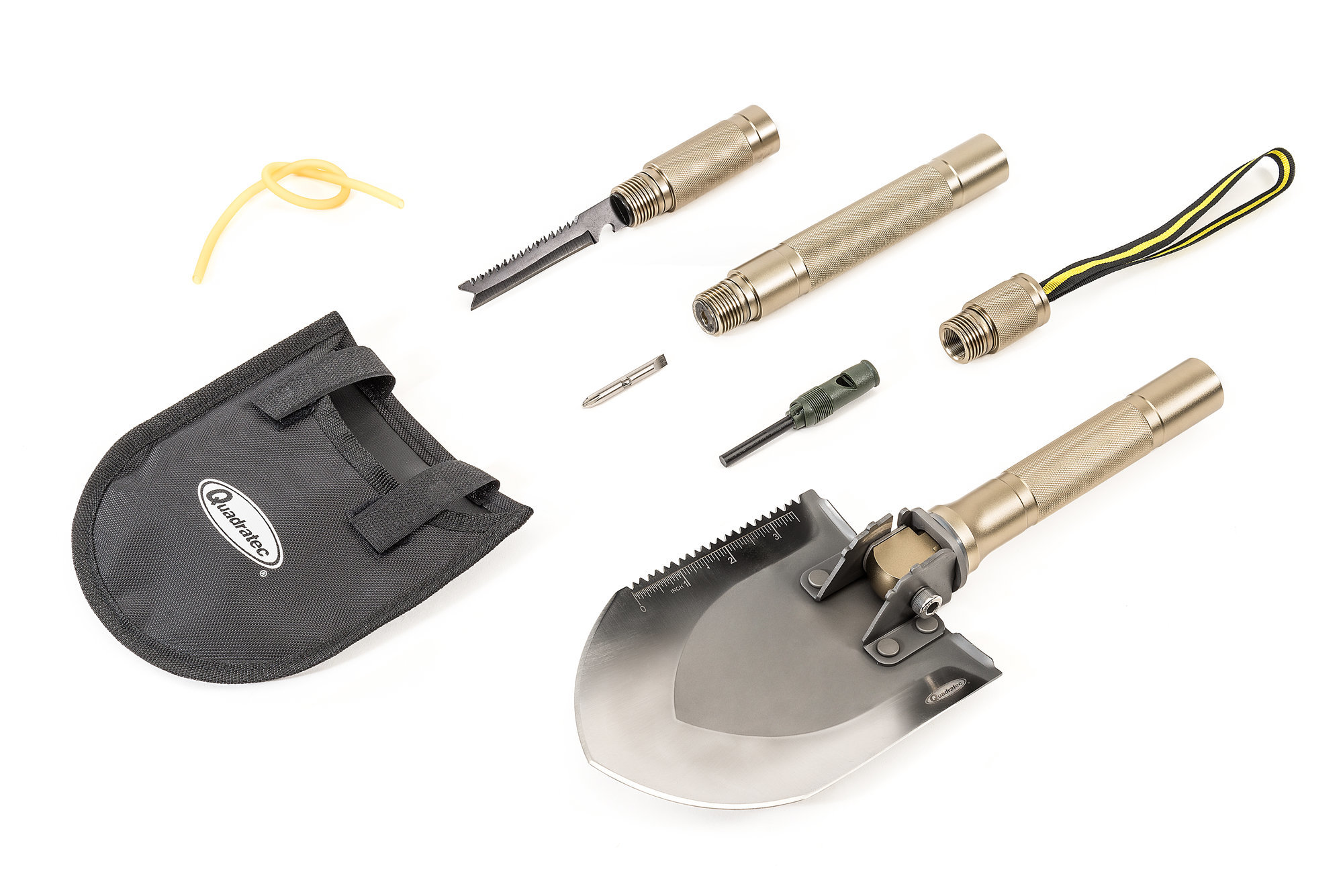
Trail Shovel
Simple to use and cost effective, a good, trusty trail shovel is something you may find yourself using every time you head off road.
Sure, you can toss that shovel from your garage into the Jeep, but a trail version offers more functionality in a more manageable size. Most can fold right up, or come apart in sections, so they do not take up much space, and they utilize a high-strength carbon steel blade that can slice through solid ground just as easily as mud, snow or sand. Plus, most have a serrated edge so they can cut as well as dig — making it an all-purpose trail tool.
These are perfect to use when clearing mud or debris from under the front tires, in order to take the strain off a winch during recovery situations. Or, to fill in ruts to assist with traction, and making a level base for an off-road jack when changing out a tire. A handy trail shovel can also pile dirt under a tire or two when high-centered in order to get off an obstacle and on your way.
A good 10-15 minutes of shoveling can often totally change out a recovery situation for the better, and save you from having to deploy other, more intensive, resources.
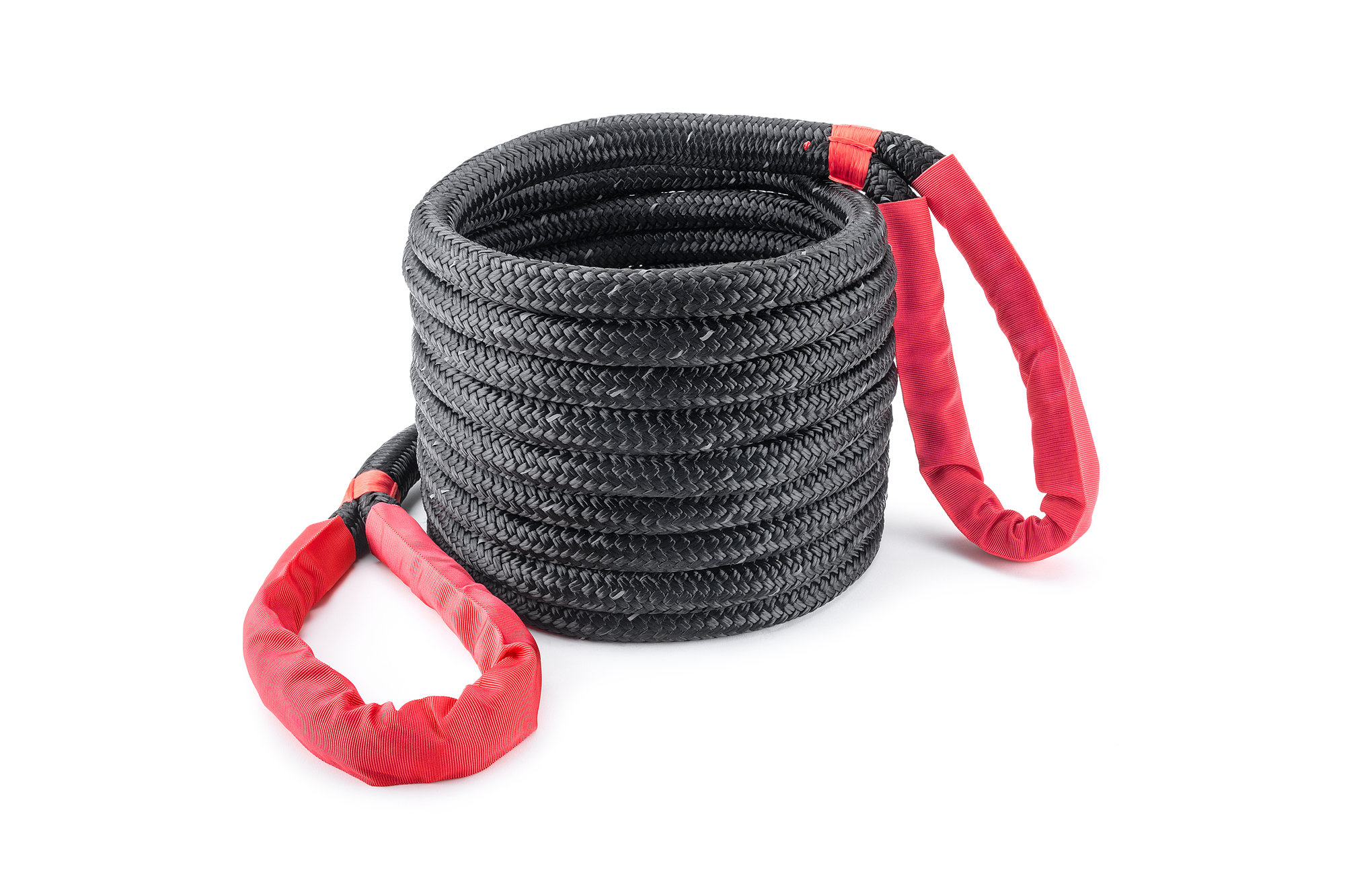
Recovery Rope
One of the biggest rules when headed off-road is to make sure your vehicle has recovery points. And the reason quickly becomes clear when your vehicle, or someone in the group, gets stuck to the point where a shovel or recovery boards do not work.
When that happens, it is time to bring out the recovery rope. These can be as simple as a tow strap with little flexibility that attaches to another ‘rescue’ vehicle, which then pulls the stuck vehicle free. Or it can be a kinetic strap that is more flexible, stores energy and acts like a slingshot to yank someone from a predicament.
Generally, tow straps are better for longer-distance pulling, while the kinetic ropes are great for those quick jobs where the pull vehicle can get a running start and use the rope’s dynamics to get the job done.
Whichever recovery rope finds its way into your vehicle, make sure you have a way to attach it to either Jeep during that recovery situation. Many tow points are closed meaning you’ll have to have either metal D-rings to attach to the specific tow point or a soft shackle.
Additionally, always make sure to check those ropes before attempting any recovery to make sure there are no cuts or frayed edges that could cause the thing to fail.
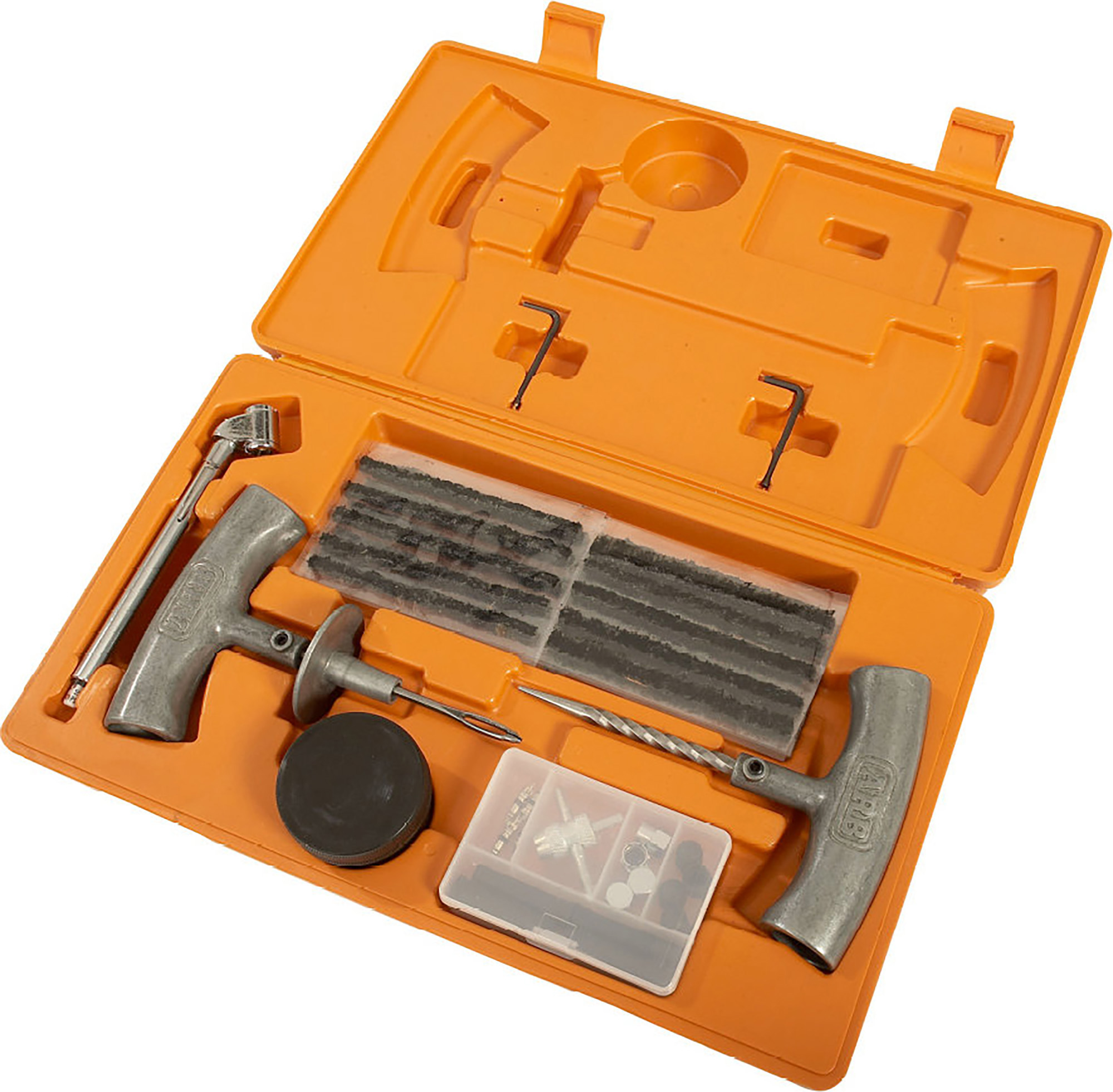
Tire Repair Kits
Nothing will stop your trail ride faster than tire failure. With most other issues, if needed, the Jeep can be towed back to the trailhead for help. But if a tire fails, then the vehicle is pretty much stuck. And it is really stuck if there is no spare tire replacement, or no way to repair that damaged tire.
Even with a spare tire in play, there is often no good or easy way to pull off a change on an uneven trail, unless you happen to get stuck on level ground or feel like digging for a while to create a decent jack position.
So investing in a tire repair kit is perfect to help overcome these situations, and especially when something like a stray nail, screw, stick, or some other form of debris punctures your tire as repairing can be a lot easier than replacing.
There are three main components that make up the core of every tire repair kit, and it’s the quality of those tools and the inclusion of some additional pieces, all designed to make repairing your tire easier, that will set the higher dollar kits apart from the lesser.
At the core of every kit, you’ll find a reamer tool, a plug insertion tool and some self-vulcanizing repair cords. The reamer tool is used to clean and de-burr the puncture, which prepares the tire for the plug. The insertion needle then physically pushes the repair plug into the puncture and sets it in place in the tire. Finally, the self-vulcanizing repair cords are the key that makes the job of plugging that tire easy and possible, all without even having to remove the tire from the wheel. In fact, most repairs can be made without having to remove the wheel from your Jeep altogether.
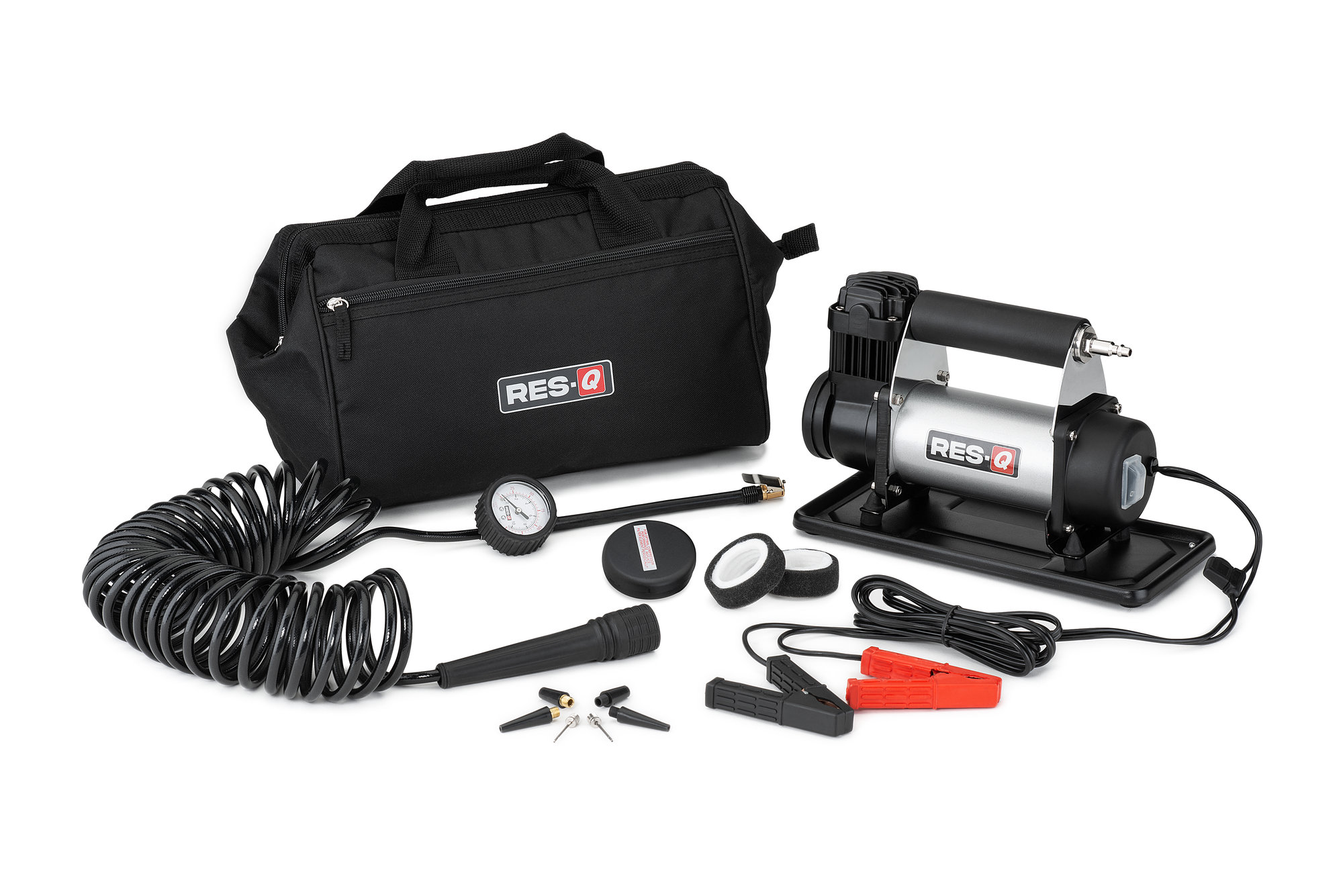
Air Compressor
If you’ve spent time off-road, you know all about the importance of airing down before heading out on the trail. If you are new to the off-road game, the crib note version is that lowering tire pressure increases surface grip. This means better traction over most types of obstacles you’ll encounter and enhanced off-road performance.
However, the flip side to this is that you need to air the tires back up before heading out on the road. You can’t just air down at home, drive to wherever for the day and then air up when you get back home.
This means having a reliable way to get that air back into those tires when trail time is over. Now, some off-road parks will have air stations at the trailhead you can use to fill the tires. But more often than not, nothing will be available and you will be responsible for finding a way to air the things back up yourself.
Additionally, if a tire should fail on the trail, having something to put air back into that rubber following a repair is crucial.
Hence the need for an air compressor system in your off-road and recovery tool set up.
Now, these compressors can range from lower cost systems to higher end tank units to integrated systems on your vehicle that can power tools and lockers, as well as air up tires.
Standard compressor kits are usually powered by attaching cables to your Jeep’s battery similar to a jump start kit, which then will inflate tires individually with slow, steady airflow. Depending on how low you air down those tires, reinflation can take some time compared to other units.
A popular compressor set up these days is the portable CO2 tank air system, as this offers a significantly higher air flow than a standard compressor — meaning a set of four tires can go from trail to full pressure in just minutes. Plus, its portability means the tank is more versatile and can be moved from the Jeep to wherever it is needed.
High end integrated onboard air systems may be overkill to some, but do offer an excellent way to quickly air up tires, while also powering lockers if needed and any air tools that may also be included in a recovery kit. These are usually kits for those who are frequent off-roaders as the powerful airflow allows for quick tire inflation, but never needs to be refilled.

Off-Road Jack
Those new to the Jeep world may not have thought about this before, but the vehicle’s tires are quite a bit larger than standard car tires. And yet, the factory jack is very similar to a car jack; meaning it is not the best when it comes time for a tire change.
Sure, those choosing to change their own tires can manage when the vehicle is on pavement, but the challenge comes when you take that Jeep off-road. Then, you quickly find out the factory jack is more trouble than it is worth as it may not be able to lift the Jeep far enough to swap tires. And it most certainly will have an issue with any larger aftermarket tires.
That is why adding an off-road jack to your recovery tool arsenal is essential.
Off-road jacks do have a few different designs and can be large 48” to 60” mechanical ones, wheeled jacks, airbag versions or hydraulic. But they all have one thing in common — they are much better than the factory jack.
The most popular ones and most economical these days are still mechanical jacks that are cast iron and at least 48” tall.
These jacks utilize a square base and have numerous holes in the long iron bar that help in pushing the vehicle off the ground. A large runner arm is placed under the bumper and then the jack’s handle slowly lifts the required tire area off the ground.
While these jacks have been around for a long time, they do require skill to use and the vehicle does need to be safely supported. It is highly recommended to practice a bit with the jack on flat surfaces if you are unfamiliar with its operation. That way, you'll be ready to go if needed on the trail.
Additionally, the jack’s base should be supported by either a larger jack base accessory, or a solid piece of wood on level ground. If there isn’t a good level spot to set up the jack, then bring out that trail shovel and create one.
Wheeled jacks are similar in use to auto shop floor jacks, and employ a long base that helps with stability and distributes weight no matter the slope or type of terrain. These can be placed into position where needed and then the lift engaged with a few handle pumps.
One of the newest off-road jacks is the hydraulic version which is significantly easier to use, as well as being lighter and smaller than the mechanical jack. These excellent features do have a premium price attached, but as the jack definitely streamlines that recovery process and requires a lot less work, it may be worth it for those who are frequently off-road.
Airbag jacks are a decent option for those who take their vehicles out more on sandy or muddy surfaces, as this jack works to lift the tire area by inflating either through the vehicle’s exhaust or an air compressor. As the vehicle is pushed off the ground via the bag’s inflation, the tire can then be swapped.

Basic Tools
No doubt you’ve often heard that having the right tool for a job is imperative. If you haven’t, then you should know that many small issues can be solved before becoming larger ones, simply by having the correct tool when needed.
Which is why adding a serious tool kit into your recovery gear is definitely recommended.
Perhaps the problem is something easy like securing a bumper or hitch that has somehow come loose. Or maybe it is a bit more extensive like a cooling problem, or battery, that needs to be corrected. Even something as unfortunate as a damaged driveline part can be worked on with the right tools..
And the best part is you don't have to be a master mechanic to utilize these tools either, as any fixes do not need to be permanent; just something adequate to get you back to the trailhead, or home and out of the elements, so you can more adequately correct the problem. However, you can't make those fixes if you don't have any tools in the first place.
Tool sets come numerous different sizes, up to 125- or 256-piece kits, so you can ensure you have exactly what you need—when you need it. Now, these kits will not include stuff like air tools or other high-powered accessories, but will offer good, solid items such as wrenches, torx bits and sockets that can take on most situations. Additionally, supplementing that kit with accessories like that trail shovel, knife or axe, will give you the ability to dig or cut your way out of trouble, thus allowing an easier recovery following a trail mishap.
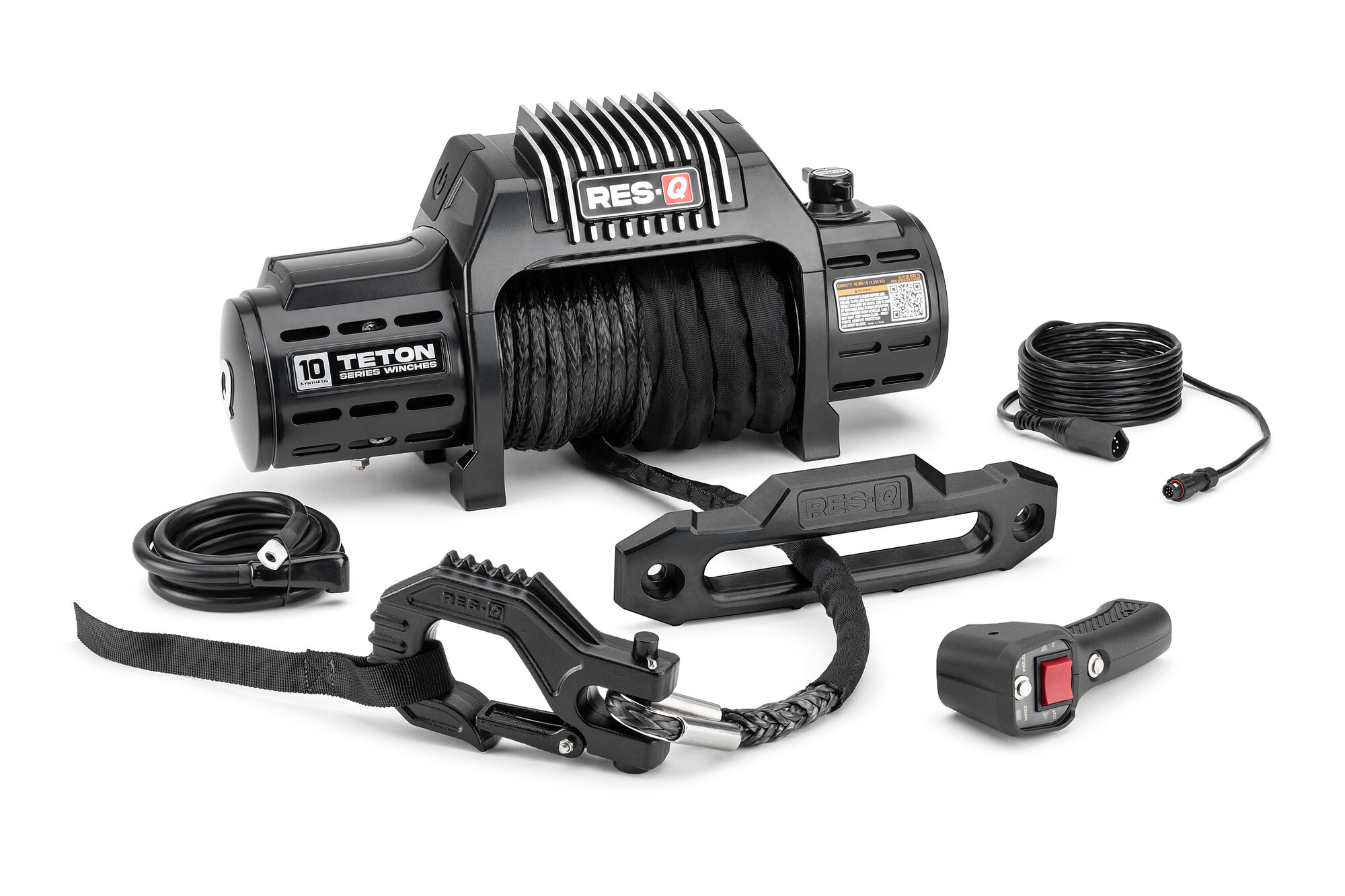
Winch
A Jeep winch is probably the most serious product you can add to your off-road and recovery product lineup. It may even carry the highest price tag. But when needed, it is also something that can prevent even more costly damage to your (or someone else’s) Jeep — especially if you are starting to test the limits of your ability on trails that are a bit more difficult.
Recovery straps are certainly helpful in many off-road recovery situations, but there will most likely come a time when you get stuck in an area where another vehicle simply cannot help you. Maybe the obstacle is to narrow, or you are at an angle where that other vehicle can’t get close enough without incurring damaged.
This is why a winch makes sense.
The slow, constant pulling power can roll your vehicle back on the trail, or through an obstacle, while giving you and any helpers a lot more control over the process.
Winches these days come in a variety of styles, with a variety of line pull ratings as well as either synthetic or wire rope. As a generic starting point, you should choose a winch pull rating around 1.5 times your vehicle’s gross weight. However, realistically, when you are off-road and possibly on many different surface types, you should choose a winch with more power. So, something in the 9,500, 10k and 12k line pull range are usually ideal for an off-road vehicle.
As far as rope type, wire ones are normally less expensive than synthetic versions, however they are also heavier and can cause issues should the line break under strain. For that reason, synthetic rope winches have been extremely popular over the past several years. Not only are they more lightweight, but the rope usually drops down upon breakage instead of whipping into the air.
From there, a winch is usually personal preference as the overall aesthetics can change from vendor to vendor, while some have Bluetooth connected remotes, and others wireless or wired. You’ll also want to see if the winch will connect directly to your vehicle’s bumper, or if you’ll need a winch plate or an entirely new bumper.












